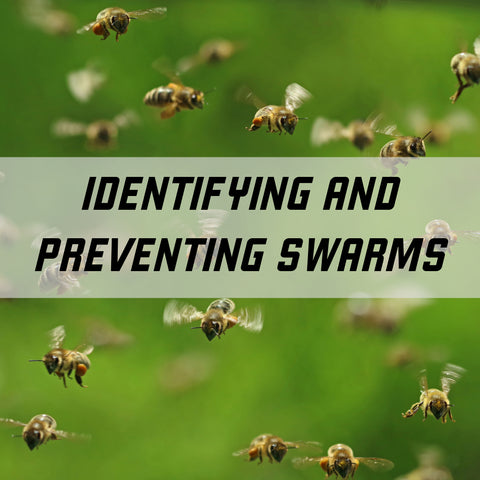IDENTIFYING AND PREVENTING SWARMS
When a hive swarms, the old queen bee and roughly half of the adult bees leave the hive and cluster on a nearby branch or surface until they find a new cavity to move into. As beekeepers, we don’t want our hives to swarm since it greatly weakens the hive. First, let’s tackle identifying a hive that is getting ready to swarm.

Here are some of the telltale signs:
- The hive is overcrowded: Anytime the top box is more than 80% full of bees in the spring or summer, you are at risk of swarming. If I’m looking at a hive and all the boxes are full of bees, I assume it’s on the verge of swarming. My next step is to look for swarm cells.
- The bees are making swarm cells: When a hive is getting ready to swarm, the bees will begin building swarm cells, which are queen cells usually on the bottom or sides of a frame of brood. See “Swarm Cells vs. Supersedure Cells.”
- A beard of bees is hanging in the front of your hive: This doesn’t always mean your hive is going to swarm. It can mean they are just a little hot and are trying to cool the hive by reducing the number of bodies inside. However, it does prompt me to add another box and check for swarm cells if the boxes are full of bees.
Fortunately, there are many ways we as beekeepers can help prevent swarms.
Providing enough space:
This is the most important swarm-prevention practice! Make sure that your hive has enough room for the bees to expand during the spring and early summer. As a general rule, when the top box (brood box or super) in the spring or early summer becomes 80% full of bees, it’s time to add another box. Following that rule will typically prevent a hive from swarming.
Splitting:
This is an incredibly common way to prevent swarms. Most beekeepers split in the spring to keep large hives from swarming. See “Splitting” for more information.
Adding a medium or shallow box under your brood boxes:
Bees are much less likely to swarm if they have empty space under their brood boxes.
Unfortunately, wiping out swarm cells rarely works, just as things like trapping the queen inside the hive don’t. Prevention really is the best option. However, it’s easy to get behind, and some hives swarm no matter what you do! What if you do see swarm cells in your hive? Keep reading!
Check out this video showing what a hive preparing to swarm looks like. Could this have been prevented?
What should I do when my hive is preparing to swarm?
First, don’t panic! Everyone has a hive swarm from time to time. Though it does reduce the strength of your hive, a strong hive can bounce back quite quickly. Second, determine how close your hive is to swarming. The best way to tell this is by looking at the swarm cells in a hive and assessing the bee population. A hive normally swarms around the time swarm cells are being capped. This leaves a relatively short window to catch the hive before they swarm. If the swarm cells are capped, you don’t see your queen, they seem to have lost a lot of their adult bees, and you don’t see fresh eggs (newly laid eggs stand up straight in the cell and tilt over a bit more each day until day three, when they lay flat on the bottom of the cell and hatch into larvae), then the hive has already swarmed. If that’s the case, see “Post Swarm Hive Care.”
Assuming you caught the hive before they swarmed, here are your options:
- Split the hive. This is the most effective way to stop a swarm. Once a hive decides to swarm, it’s really hard to change their minds! Splitting the hive into two or three new hives and giving each a frame with a swarm cell is not only a great way to create more hives but almost always shuts down their swarming impulses.
- Wipe out the swarm cells, and hope you didn’t miss one! This doesn’t usually work very well. We beekeepers often miss a cell or the hive swarms anyway, even if you did wipe out all the cells.
- Let them swarm. You can let nature take its course and try to catch the swarm and put it in a new hive. This can work pretty well, assuming they cluster where you can reach them. See “Catching Swarms.”
- Some have limited success with capturing the queen, putting her in a queen cage, wiping out the swarm cells, and adding a box to the hive. About a week later, they release the queen again. While this can work, if you miss a swarm cell, the hive will often swarm with the virgin queen. It’s also just as much work or more than making a split, with poorer success rates.
This hive is a great example of what a hive that needs our attention to prevent swarming will look like.

